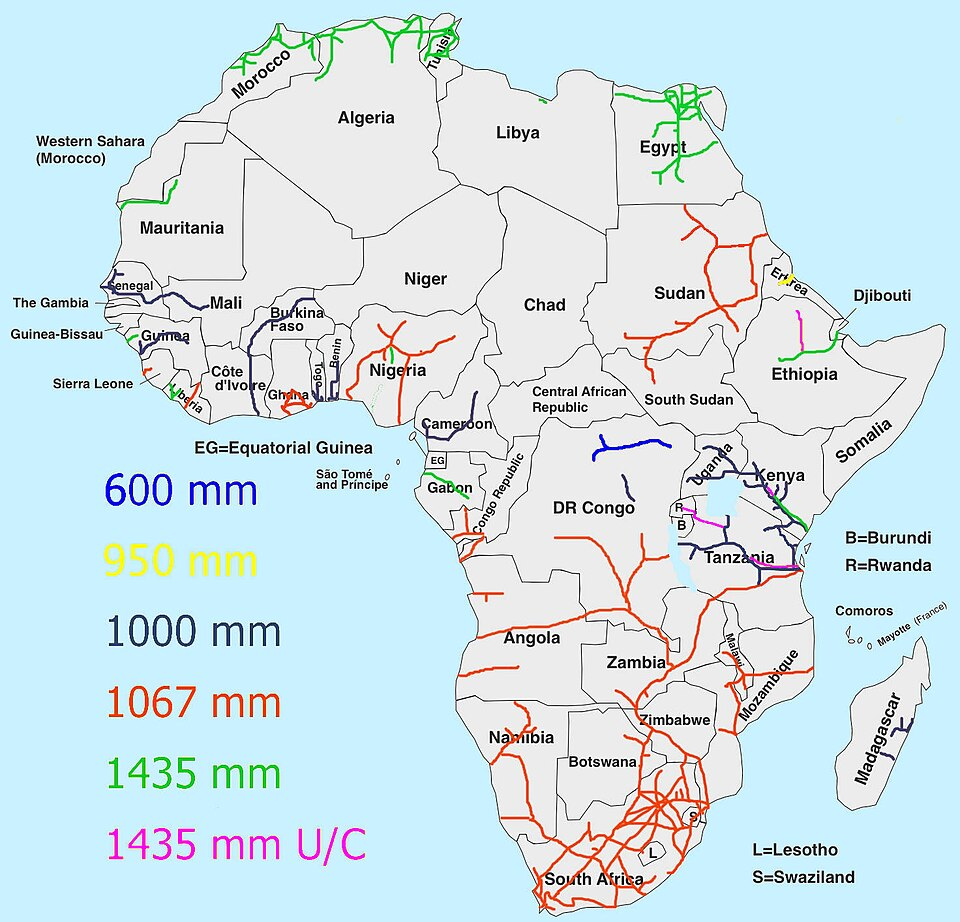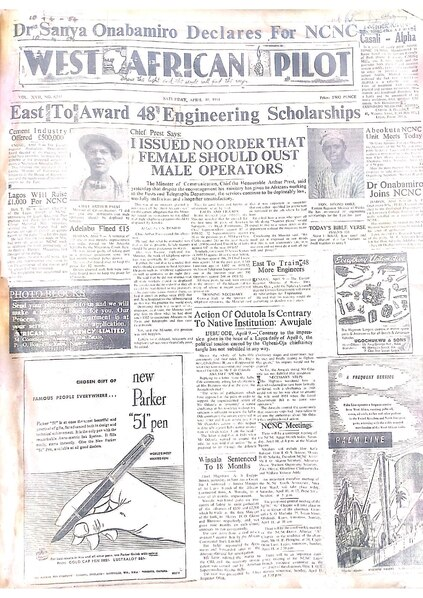IB Syllabus focus:
'Examine the social and cultural impact of technological developments on African communities during the 19ᵗʰ and 20ᵗʰ centuries.'
Technological progress during the 19th and 20th centuries profoundly influenced the societal and cultural frameworks of African nations, moulding contemporary African identities.
Introduction to Technological Influences
In the span of two centuries, technology dramatically transformed Africa's social and cultural fabric, leading to unprecedented shifts in various aspects of daily life, work, and community.
Transportation Revolution and Its Social Implications
The Steam Engine's Arrival
Railway Expansion: Propelled the creation of an interconnected continent, reduced isolation of communities.

This schematic map shows the principal railway lines across Africa and the gauges used, illustrating how rail infrastructure knitted regions together and channelled migration toward rail hubs. While the gauge information exceeds syllabus requirements, it helps explain regional interoperability challenges that shaped movement and markets. Source
Urbanisation: Facilitated the rise of cities as people migrated towards railway hubs.
Maritime Innovations
Steamships: Enhanced seaborne trade and contact with the global economy.
Port Cities: Became cultural melting pots due to increased international interactions.
Communication Breakthroughs Reshaping Society
Telegraph and Telephone
Instant Communication: Reduced the sense of distance, enabling prompt political and social discourse.
Cultural Exchange: Encouraged the exchange of ideas and customs across different regions.
The Impact of Print
Newspapers and Books: Fostered a culture of reading and education, empowering literate societies.
Pan-Africanism: Ideas about unity and independence spread more effectively.

The front page of the Nigerian newspaper West African Pilot (10 April 1954) illustrates how mass-circulation print media amplified political discussion and nationalist messaging across urban networks. Source
Cultural Reorientation through Technological Adoption
Alterations in Artistic Expression
Photography: Introduced new forms of preserving and interpreting cultural heritage.
Cinematography: Began to reflect and shape societal norms and values.
Music’s Technological Infusion
Recording Studios: Enabled the preservation and commercial distribution of African music.
Radio Broadcasting: Popularised different music genres, integrating them into daily life.
Health Innovations and Environmental Impact
Western Medicine’s Introduction
Vaccinations and Treatments: Decreased the prevalence of fatal diseases, altering life expectancy.
Biomedical Facilities: Their establishment often encountered resistance due to differing cultural beliefs on healing.
Agricultural Modernisation
Mechanisation: Tractors and harvesters introduced, increasing yields but disrupting traditional farming methods.
Ecological Consequences: Cash crops like cotton and cocoa replaced diverse ecosystems, leading to soil depletion.
Education: A New Technological Frontier
Evolution of Educational Systems
Curricular Shift: Western curricula focused on science and technology, marginalising indigenous knowledge.
Technical and Vocational Training: Responded to the new needs of the industrialising economies.
Women’s Evolving Educational Role
Barriers and Breakthroughs: Gradual dismantling of educational barriers for women, leading to their increased presence in technological fields.
Work and Technological Adaptation
The Industrial Mining Boom
Technology in Mining: Sophisticated machinery introduced, changing the labour landscape.
Migrant Labour System: Contributed to the erosion of traditional family structures, as men worked far from home.
From Farm to Factory
Industrial Jobs: Offered alternative employment to agriculture, influencing migration patterns.
New Social Classes: The emergence of a working class and middle class redefined social hierarchies.
Technological Advances Facing Opposition
Skepticism and Resistance
Certain technologies were met with scepticism, perceived as threats to cultural practices and social order.
Rituals and ceremonies often adapted to address these technological intrusions.
Indigenous Knowledge at the Crossroads
Traditional methods and tools became undervalued, risking the loss of cultural heritage.
Deliberate efforts were made to document and integrate traditional skills with modern practices.
The Dual Edge of Colonial Technological Impact
Infrastructure as a Means of Control
Technological tools were employed to tighten colonial grip, often disregarding local needs.
Resource Exploitation: Mining and cash-crop agriculture were intensified by technology, exacerbating economic dependency.
Adaptation and Agency
Africans used technology creatively to advance anti-colonial movements and to bolster cultural resilience.
Modified technologies to suit local environments, demonstrating innovation and adaptability.
Urbanisation: A Product of Technological Growth
Metropolises and Change
Technology spurred the development of major cities, which became hotbeds of cultural innovation.
The rise of modern African literature, film, and art often centred around urban experiences.
Enhancements in Urban Living
Introduction of sanitation systems, electrical grids, and concrete housing improved living conditions.
City planning incorporated green spaces and public transport, leading to more organised and sustainable urban growth.
The Century's Close: Reflecting on Technology's Role
In retrospect, the final decades of the 20th century in Africa can be seen as a period where technology acted as a catalyst for cultural renaissance while also presenting challenges to traditional life. The continent's social and cultural identity had been indelibly transformed, bearing the imprints of technological innovation.
By the end of the 20th century, technology had woven itself into the continent's cultural fabric, affecting everything from art to social structures, and paving the way for a modern Africa that was both a participant in and contributor to global technological advancements.
FAQ
Technological advancements significantly influenced African languages and literacy rates. The introduction of the printing press made it possible to produce literature in African languages, which facilitated the spread of literacy and helped preserve languages through written records. However, colonial education policies often prioritised European languages for instruction and administration, relegating African languages to lesser status. This had the effect of increasing literacy in the colonial language while also undermining the use of indigenous languages in formal education and literate discourse. The 20th century saw a pushback against this trend, with many African nations promoting literacy in local languages as part of post-colonial nation-building efforts, using technology to support the development and standardisation of linguistic resources.
The influx of foreign technologies had a multifaceted effect on indigenous African industries and craftsmanship. On one hand, it led to a decline in traditional crafts that could not compete with the mass-produced goods brought by colonial powers. Local industries, such as textile production, faced significant competition from imported fabrics, which were often cheaper and more accessible due to the technological superiority of colonial manufacturing. On the other hand, some African craftsmen adapted by incorporating new materials and techniques into their work, resulting in innovative hybrid forms of craftsmanship. While the displacement of traditional industries often resulted in economic and cultural loss, the adaptive measures taken by some sectors demonstrated resilience and the capacity to engage with global technological changes while retaining distinctive cultural identities.
Technological development was crucial in the spread of political ideas and movements across Africa, especially during the independence and post-independence periods. The telegraph and later, the telephone, allowed for rapid communication between leaders of independence movements. Print technology enabled the wide distribution of political pamphlets and newspapers, which were instrumental in spreading anti-colonial sentiments and mobilising people. Radio broadcasts played a significant role in disseminating information and nurturing a sense of unity among diverse ethnic groups by presenting news and political ideas in local languages. Together, these technologies helped to overcome geographical and linguistic barriers, fostering solidarity and facilitating coordinated political action that was vital to the success of nationalistic movements.
Film and photography played critical roles in documenting and shaping perceptions of African colonial history. Initially used by colonisers to portray their perceived civilising mission, these technologies later became tools for Africans to record their own narratives. Photography allowed for the visual representation of colonial impact, documenting both the exploitation and the everyday lives of people under colonial rule. As Africans gained access to cameras and film, they began to produce images and movies that reflected their experiences and cultural values, contesting colonial narratives. This shift enabled Africans to contribute to historical discourse, challenge stereotypes, and celebrate their cultural heritage. Furthermore, images and films became historical sources that provided insights into the colonial era from multiple perspectives, enriching our understanding of African history.
The introduction of Western medicine had a significant impact on the roles of traditional healers and midwives in Africa. Western medical practices, often introduced through colonial administration, initially faced resistance from local communities due to their departure from traditional methods of healing. Traditional healers, who were deeply respected within their communities for their knowledge of herbal remedies and spiritual guidance, found their roles diminishing or being challenged. Conversely, midwives had to adapt to new birthing practices and hygiene standards imposed by Western medicine. Over time, the interplay between Western and indigenous practices led to a hybrid medical system in many parts of Africa, wherein traditional and Western methods coexist and sometimes complement each other. The transition also catalysed a dialogue between modern and traditional practitioners, fostering a broader understanding of health care practices.
Practice Questions
Technological advancements during the 19th and 20th centuries profoundly reshaped African social structures. The introduction of railways and industrial machinery facilitated urbanisation, creating new social classes and transforming traditional community bonds. As men migrated for work, family dynamics shifted, often leading to the erosion of patriarchal extended families and the emergence of nuclear family units in urban settings. However, the impact was not uniform across the continent, as some rural areas maintained traditional structures, showing the extent of change varied with accessibility to and adoption of technology.
The infusion of technology in Africa brought about a rich tapestry of cultural expression. Recording devices and radio broadcasted African music wider, influencing global music and local traditions. The introduction of cinema and photography provided new mediums of storytelling and preservation of culture. However, this also led to a cultural dichotomy where traditional art forms were both preserved and challenged by new technologies. The extent of influence was profound, as technology enabled cultural preservation while simultaneously ushering in modern forms of expression that reflected the continent's evolving identity amidst global influences.

